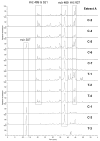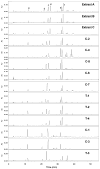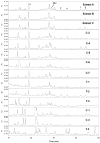Evaluation of the botanical authenticity and phytochemical profile of black cohosh products by high-performance liquid chromatography with selected ion monitoring liquid chromatography-mass spectrometry
- PMID: 16637680
- PMCID: PMC3204370
- DOI: 10.1021/jf0606149
Evaluation of the botanical authenticity and phytochemical profile of black cohosh products by high-performance liquid chromatography with selected ion monitoring liquid chromatography-mass spectrometry
Abstract
Black cohosh (Actaea racemosa L., syn. Cimicifuga racemosa L.) has become increasingly popular as a dietary supplement in the United States for the treatment of symptoms related to menopause, but the botanical authenticity of most products containing black cohosh has not been evaluated, nor is manufacturing highly regulated in the United States. In this study, 11 black cohosh products were analyzed for triterpene glycosides, phenolic constituents, and formononetin by high-performance liquid chromatography-photodiode array detection and a new selected ion monitoring liquid chromatography-mass spectrometry method. Three of the 11 products were found to contain the marker compound cimifugin and not cimiracemoside C, thereby indicating that these plants contain Asian Actaea instead of black cohosh. One product contained both black cohosh and an Asian Actaea species. For the products containing only black cohosh, there was significant product-to-product variability in the amounts of the selected triterpene glycosides and phenolic constituents, and as expected, no formononetin was detected.
Figures







Similar articles
-
Phytochemical fingerprinting to thwart black cohosh adulteration: a 15 Actaea species analysis.Phytochem Anal. 2011 Jul-Aug;22(4):339-51. doi: 10.1002/pca.1285. Epub 2011 Feb 19. Phytochem Anal. 2011. PMID: 21337649
-
Cimicifuga species identification by high performance liquid chromatography-photodiode array/mass spectrometric/evaporative light scattering detection for quality control of black cohosh products.J Chromatogr A. 2006 Apr 21;1112(1-2):241-54. doi: 10.1016/j.chroma.2006.01.004. Epub 2006 Mar 2. J Chromatogr A. 2006. PMID: 16515793 Free PMC article.
-
Stability evaluation of selected polyphenols and triterpene glycosides in black cohosh.J Agric Food Chem. 2008 Oct 22;56(20):9510-9. doi: 10.1021/jf802481w. Epub 2008 Sep 26. J Agric Food Chem. 2008. PMID: 18817410 Free PMC article.
-
Ethnobotany, Phytochemistry, Traditional and Modern Uses of Actaea racemosa L. (Black cohosh): A Review.Adv Exp Med Biol. 2021;1308:403-449. doi: 10.1007/978-3-030-64872-5_24. Adv Exp Med Biol. 2021. PMID: 33861455 Review.
-
Authentication of the botanical origin of Western herbal products using Cimicifuga and Vitex products as examples.J Nat Med. 2016 Jul;70(3):361-75. doi: 10.1007/s11418-016-1006-0. Epub 2016 May 17. J Nat Med. 2016. PMID: 27188194 Free PMC article. Review.
Cited by
-
Chemical Authentication of Botanical Ingredients: A Review of Commercial Herbal Products.Front Pharmacol. 2021 Apr 15;12:666850. doi: 10.3389/fphar.2021.666850. eCollection 2021. Front Pharmacol. 2021. PMID: 33935790 Free PMC article. Review.
-
The Importance of Method Selection in Determining Product Integrity for Nutrition Research.Adv Nutr. 2016 Mar 15;7(2):390-8. doi: 10.3945/an.115.010611. Print 2016 Mar. Adv Nutr. 2016. PMID: 26980823 Free PMC article. Review.
-
Metabolic profiling of Actaea species extracts using high performance liquid chromatography coupled with electrospray ionization time-of-flight mass spectrometry.J Chromatogr A. 2011 Mar 18;1218(11):1461-76. doi: 10.1016/j.chroma.2011.01.033. Epub 2011 Jan 19. J Chromatogr A. 2011. PMID: 21316686 Free PMC article.
-
Fukinolic acid derivatives and triterpene glycosides from black cohosh inhibit CYP isozymes, but are not cytotoxic to Hep-G2 cells in vitro.Curr Drug Saf. 2010 Apr;5(2):118-24. doi: 10.2174/157488610790936150. Curr Drug Saf. 2010. PMID: 20406160 Free PMC article.
-
Liver Injury with Features Mimicking Autoimmune Hepatitis following the Use of Black Cohosh.Case Rep Med. 2009;2009:918156. doi: 10.1155/2009/918156. Epub 2010 Jan 10. Case Rep Med. 2009. PMID: 20130783 Free PMC article.
References
-
- Barton BS. Collections for an Essay Towards a Material Medica of the United States. Way & Groff; Philadelphia: 1798. p. 9.
-
- Rafinesque CS. Medical Flora or Manual of the Medical Botany of the United States of North America. Atkinson & Alexander; Philadelphia: 1828. p. 88.
-
- Borrelli F, Izzo AA, Ernst E. Pharmacological effects of Cimicifuga racemosa. Life Sci. 2003;73:1215–1229. - PubMed
-
- Kronenberg F, Fugh-Berman A. Complementary and alternative medicine (CAM) for menopausal symptoms: A review of randomized control trails. Ann Intern Med. 2002;137:805–813. - PubMed
-
- Warnecke G. Beeinflussung klimakterischer beschwerden durch ein phytotherapeutikum: Erfolgreiche therapie mit Cimicifuga-monoextrakt. Med Welt. 1985;36:871–874.
Publication types
MeSH terms
Substances
Grants and funding
LinkOut - more resources
Full Text Sources
Other Literature Sources
Miscellaneous

